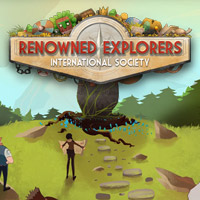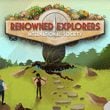Renowned Explorers: International Society review – feeling like Indiana Jones
Abbey Games Studios once again wants to challenge all fans of the strategy genre. This time, the Dutch team will put you in the shoes of 19th century treasure hunters to take part in their thrilling adventures, often on par with those of Indiana Jones.
The review is based on the PC version.
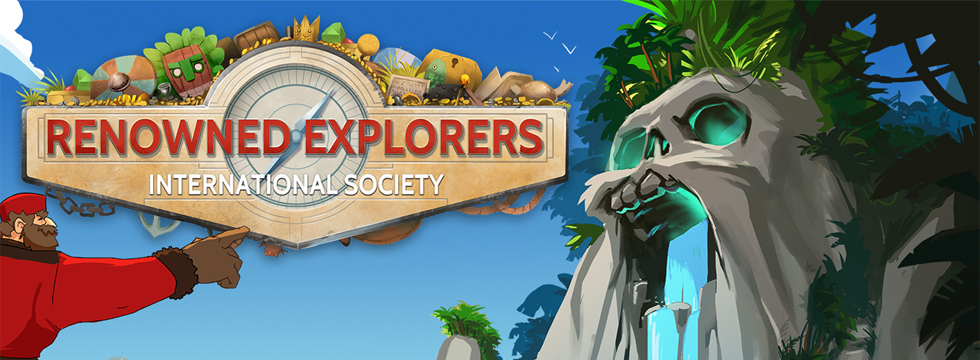
- the atmosphere;
- interesting gameplay mechanics, employing several original solutions;
- many hours of fun;
- diversified difficulty level;
- pleasant visuals;
- requires strategic thinking.
- some of the gameplay mechanics are left without proper introduction;
- (for some people) randomness to certain elements of the game;
- repetitive soundtrack;
- some small technical issues.
Renowned Explorers: International Society is one of that games that can confuse, when you first see them. Simply because there’s no other title to compare it to and prepare you for what’s for you in store. The brief tutorial doesn’t help much either; it does spare you the details, but at the same time, it doesn’t cover everything it should. It doesn’t take much time, however, to see that under the guise of adventurous undertakings there are a lot of things we’ve seen before.
Our endeavor begins as we assemble a multinational team of three explorers, beginning with its Captain. Every explorer is assigned four characteristics: class (Scientist, Fighter, Scout, or Speaker), perks, stats (defining the number of “lives”, attack power, defenses and so on), and a unique trait that is in effect only when a character is chosen as the team’s Captain. Tough choices from the very beginning, it would seem. Luckily, the creators have prepared descriptions for each explorer that suggest some good companions to complement him/her – you can just follow one of their suggestions, if you’d like.
The main objective of the game is to gain the title of the world’s most Renowned Explorer, defeating your rival – Frenchman Matthieux Rivaleux and his colleagues. To do that, you need to gather two thousand Renown points; points that are awarded for several things you do in the game, but mostly for discovering old treasures.
There are three elements to the gameplay – preparations, the expedition itself, and the tactical combat. Let’s begin from the end. The hex grid on the battlefield brings you back to the oldschool turn-based strategies, and in fact the combat here is similar. Sometimes, you can find special fields on the battlefield that restore the health (or “spirit points”) of your explorers every turn.
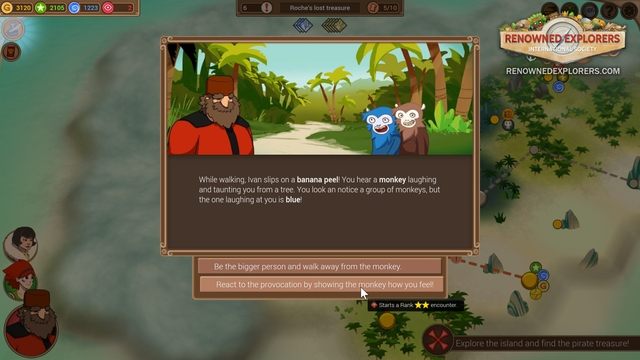
The way you fight is defined by the game’s biggest innovation. The backbone of the combat gameplay is the approach (dubbed as attitude) your team decides to take: aggressive, friendly, or devious. Skills and physical attacks of your explorers are classified in the same manner. Using skill or an attack of a given type can change the explorer’s attitude in combat. For example: physically hitting the opponent will set your attitude as aggressive, and telling him a joke (it damages the enemy’s spirit points as a physical attack would) afterwards will change it further to friendly. That’s important, because the attitudes of clashing parties are subjected to a comparison and generate the overall mood of the fight. That mood can bestow upon you both positive and negative modifiers.
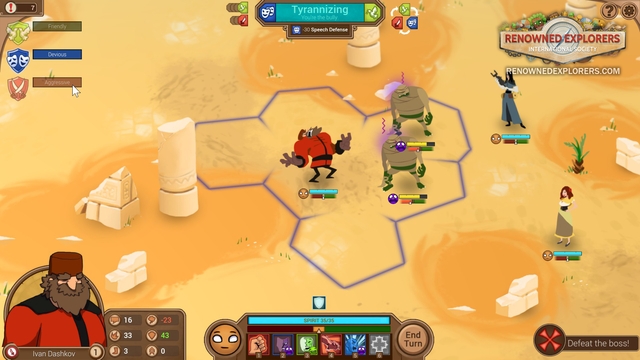
The modifiers are dependent on the comparison of attitudes, following the “rock-paper-scissors” pattern, i.e. aggressive attitude works well against friendly opponents, offering you a very useful fight mood bonus. Although the whole thing may seem very complicated in theory it is very intuitive in practice, and it takes only a brief moment to gain the necessary tactical knowledge. The attitude mechanics encourages careful application of skills and attacks – not always what hurts enemy the most is necessarily the most strategically sound option.
Furthermore, your team attitude at the moment you win an encounter determines your reward, as well as the aftermath of the encounter. Then, at the end of the expedition, the game evaluates your overall attitude throughout its duration, which will influence your team’s reputation, and subsequently, the mindsets of the characters you meet during your travels. Unfortunately, the creators forgot to explain, specifically what consequences are being brought by your reputation.
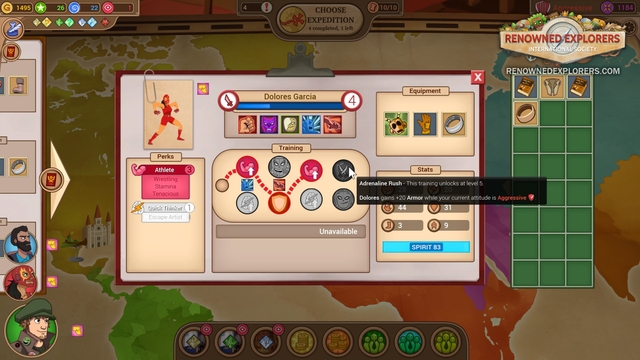
The second important gameplay element that has an impact on the combat are the emotions. Every skill has a chance to evoke a specific feeling in the opponent – positive ones (they can become excited, impressed, or confident) as well as negative ones (enraged, sad, or scared). Most of them instill a negative effect (i.e. reduced attack power), with the exception of excitation and confidence, which are clearly positive. As a consequence, sometimes, when you attack the enemy, you can boost his stats. That’s one more reason to carefully consider the right moment to use certain skills.
The three explorers that you picked for your team at the beginning take part in combat as your fighters. When one of them is rendered incapacitated, you lose a Resolve point, but the character can be revived by a team mate. The number of Resolve points is limited, and when it is spent, you lose the fight or the whole game (depending on chosen difficulty level). Resolve points can also be lost as a consequence of the team’s actions on the map, so better keep an eye on them.
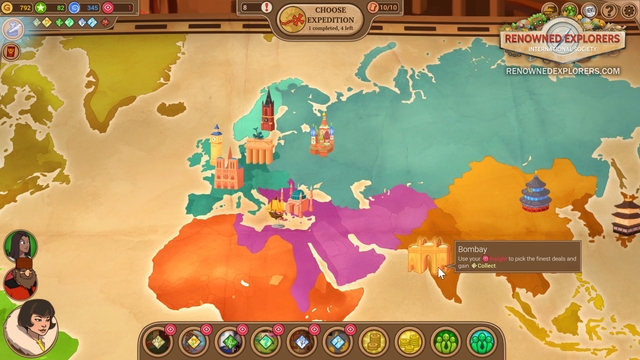
The combat in RE: IS is all about tactical approach, especially, because every fight can be won with varying results. Sometimes, the victory can reward you accordingly to your character’s trait (i.e. you get extra gold, when winning with devious attitude), for the price of a rare treasure (which you could have been given, should you win with a friendly attitude). On other occasion, it may turn out that an aggressive victory would be the most beneficial option, except it may be too much for your team as their skills are more friendship-focused. Without a doubt, combat is the most interesting, and at the same time the hardest aspect of this game.
Now, let’s focus on the second major gameplay element – the expeditions, as that’s where the combat, as well as a lot of other things, happens. The expedition map is divided into fields, with your team moving like pieces on a board game. Most fields feature some kind of event or an item, including treasures, resources (Gold - necessary to buy equipment, Research points to gain various technological bonuses, and Status points to upgrade shops and recruit helpers), Supplies and/or Resolve points. While on the exploration map, the resource points are awarded as tokens - at the end of the expedition the tokens are converted to points, which can be spent on the world map; more on that, later. The events that await you during expedition include encounters (hostile or not, which can be resolved in several ways, depending on the abovementioned attitude mechanics and your decisions) or various kinds of challenges, where the results can, once again, depend on your decisions (i.e. choosing to go left or right in a tunnel), or the outcome of the challenge based on the skills of your explorers.
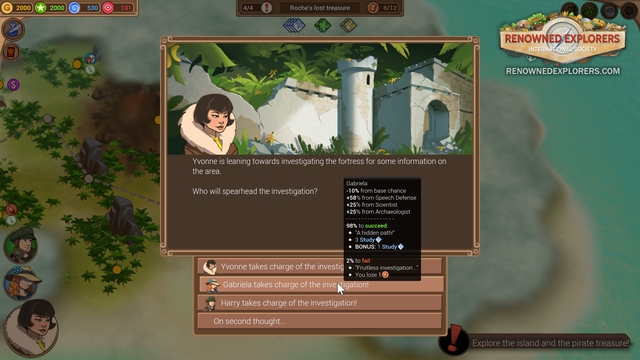
Moving you team through the map will cost you Supplies. If you run out of Supplies, each subsequent move will result in a negative modifier for one of your explorers, which will lower his or her stats during encounters. To avoid it, you should try to plan the route of your expedition beforehand. To make things more interesting, the map is covered with fog, and only the closest fields are visible. The goal of every expedition is to reach its main objective, visible on the map from the very beginning, so you don’t have to spend moves on searching for it. At the objective, a legendary object or treasure awaits you, based on the specific region of the world you are currently exploring. When in Egypt, it will be a pyramid, in the Caribbean a treasure hidden in a cove, or a forgotten fort in Hungary. The objective is always guarded by a boss, who needs to be defeated in order to complete the expedition.
The most important thing is that the map for every expedition is procedurally generated, which means each time you begin the game, even when visiting the same place, the map, the events, and the items will be different. Only the main objective remains the same, but the treasure you find there is decided by your choices or by pure chance. The treasures you obtain are added to your collection, so you might want to complete the game more than once to get them all. Some of you may turn your noses up at the randomly generated elements (challenges and treasures mostly), but I, for one, think it’s a good idea. It adds an element of surprise to every expedition, and forces you to take some risks to complete it.
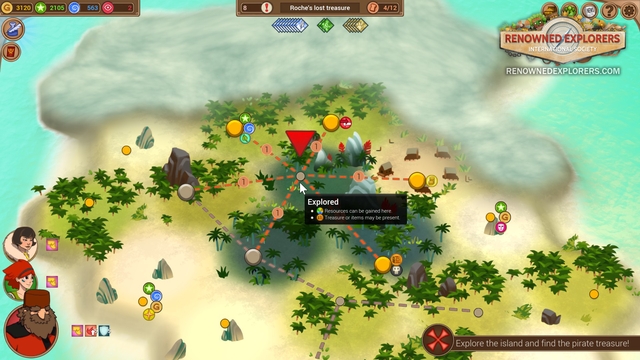
The third key aspect to the game is the preparation. Between subsequent expeditions, you are taken to the world map, where you can spend resources you gathered and pick your next destination region. Each region features existing cities, like Berlin, Paris, or Moscow, but that’s just a kind flavoring, as the location itself doesn’t really matter during the gameplay. There are two shops available in every region – one to buy equipment for gold, and the other to hire some helpers or specialists (and gain bonuses they provide) in exchange for Status points. Furthermore, the world map is where you can unlock technologies, using Research points. There’s a special tab, similar to the virtue tree from Civilization: Beyond Earth. A region also features three locations, where you can take jobs. Jobs allow you to exchange your insight points (you gain them mainly by finding treasures) for the other resources. Furthermore, different cities are available as you complete expeditions in various regions. For example, after the expedition to Hungary you will gain access to different cities that after an expedition in Egypt. Once again, you should carefully plan where to travel next, to match the location to your preferred gameplay style and aims.
After the preparations are done, you can begin a new expedition. There are 10 legendary locations, ranked by difficulty level, but not all of them are unlocked from the beginning. Furthermore, during a single playthrough, you can complete only five expeditions. After the fifth one, the most Renowned Explorer gets elected and the game ends. If you don’t gather a sufficient number of Renown points to best your arch-nemesis – you lose. The true challenge, however, awaits those, who would like to take place among the legendary explorers, which requires gathering five thousand Renown points.

Speaking of challenges, the difficulty level is decided by the player at the beginning. You choose between one of the two game modes: the discovery mode and the adventure mode. In the former, you can save the game at any moment, and restart it after losing all of your Resolve points. In the latter mode, after losing your Resolve the game ends, permanently. In theory, because somehow I’ve manage to load the game using the menu (I don’t know if the creators did it intentionally, or they simply overlooked that possibility), albeit even then I had to restart the expedition. Additionally the game features also classic difficulty levels. If you decide to choose the impossible difficulty on adventure mode and aim for the five thousand Renown threshold, you’re in for one tough challenge.
When you begin to play Renowned Explorers you may think it’s just another simple indie game. As it turns out, the developers from Abbey Games offers a significant number of creative solutions. Interesting mechanics are complimented by the gorgeous atmosphere of the game with its humoristic approach to a setting we rarely see in video games. All wrapped up in very pleasant visuals. As far as the technical aspects go, only the somewhat repetitive music and some minor interface issues (like overlapping menu elements) could be pointed out as negatives. In the dozen+ of hours I’ve spent playing the game, I haven’t witnessed a single freeze or crash – it’s getting hard finding such performance lately.
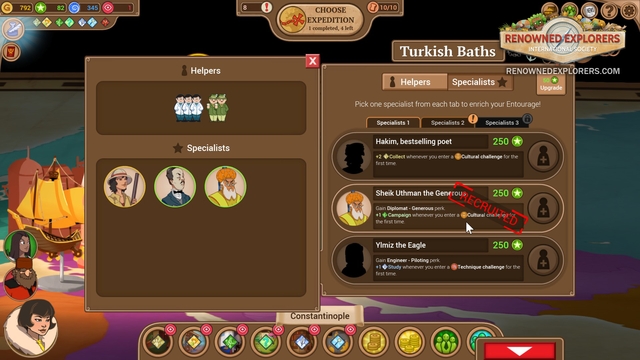
A single playthrough on normal difficulty takes roughly 4 hours. If by then, the game doesn’t have you hooked, nothing what happens afterwards will change that. It got me hooked alright, and soon I found myself picking a new team of explorers to try a different strategy. Unfortunately, the subsequent playthroughs weren’t different enough to praise the game for its replay value, which is the crucial aspect for this kind of game, and, as a result, the final score has suffered a bit. Nevertheless, if you like turn-based strategy games, would like to try a fresh approach to old mechanics, and have nothing against a short playthrough time, you can add one point to the score.
Renowned Explorers: International Society
Renowned Explorers: International Society review – feeling like Indiana Jones
Abbey Games Studios once again wants to challenge all fans of the strategy genre. This time, the Dutch team will put you in the shoes of 19th century treasure hunters to take part in their thrilling adventures, often on par with those of Indiana Jones.
